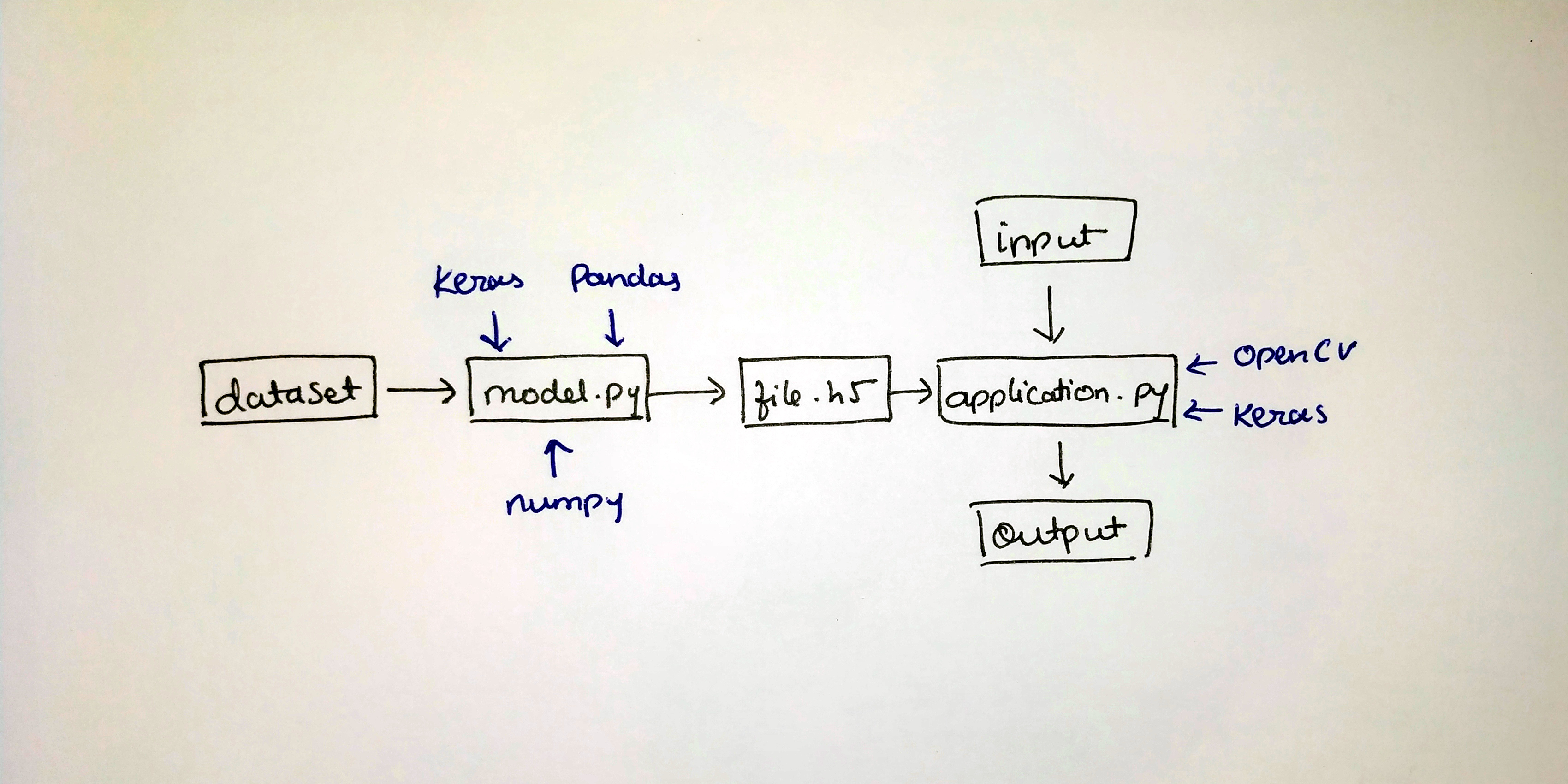In this project
We will use Devnagiri Handwritten Character Dataset which can be downloaded here.
Also, this project is implemented in Python 3.7.
And, libraries used are-
Design
We will create two classes here.
- Model
- Application
Model class will be responsible for creating a model using character dataset and Application class will recognize Hindi characters in runtime.

We begin here…
model.py
import numpy as np
import pandas as pd
from keras import layers
from keras.layers import Input, Dense, Activation, ZeroPadding2D, BatchNormalization, Flatten, Conv2D
from keras.layers import AveragePooling2D, MaxPooling2D, Dropout, GlobalMaxPooling2D, GlobalAveragePooling2D
from keras.utils import np_utils, print_summary
from keras.models import Sequential
from keras.callbacks import ModelCheckpoint
Load Data
data = pd.read_csv("data.csv")
dataset = np.array(data)
np.random.shuffle(dataset)
X = dataset
Y = dataset
X = X[:, 0:1024]
Y = Y[:, 1024]
Pre-process Data
Train and Test data variables
X_train = X[0:70000, :]
X_train = X_train / 255.
X_test = X[70000:72001, :]
X_test = X_test / 255.
# Reshape
Y = Y.reshape(Y.shape[0],1)
Y_train = Y[0:70000, :]
Y_train = Y_train.T
Y_test = Y[70000:72001, :]
Y_test = Y_test.T
print("number of training examples = " + str(X_train.shape[0]))
print("number of test examples = " + str(X_test.shape[0]))
print("X_train shape: " + str(X_train.shape))
print("Y_train shape: " + str(Y_train.shape))
print("X_test shape: " + str(X_test.shape))
print("Y_test shape: " + str(Y_test.shape))
Lets see what we have
number of training examples = 70000
number of test examples = 2000
X_train shape: (70000, 1024)
Y_train shape: (1, 70000)
X_test shape: (2000, 1024)
Y_test shape: (1, 2000)
Back to code…
image_x = 32
image_y = 32
train_y = np_utils.to_categorical(Y_train)
test_y = np_utils.to_categorical(Y_test)
train_y = train_y.reshape(train_y.shape[1],train_y.shape[2])
test_y = test_y.reshape(test_y.shape[1],test_y.shape[2])
X_train = X_train.reshape(X_train.shape[0],image_x, image_y,1)
X_test = X_test.reshape(X_test.shape[0],image_x, image_y,1)
print("X_train shape: " + str(X_train.shape))
print("Y_train shape: " + str(train_y.shape))
What we got here
X_train shape: (70000, 32, 32, 1)
Y_train shape: (70000, 37)
Define Model
def keras_model(image_x,image_y):
num_of_classes = 37
model = Sequential()
model.add(Conv2D(filters=32, kernel_size=(5, 5), input_shape=(image_x, image_y, 1), activation='relu'))
model.add(MaxPooling2D(pool_size=(2, 2), strides=(2, 2), padding='same'))
model.add(Conv2D(64, (5, 5), activation='relu'))
model.add(MaxPooling2D(pool_size=(5, 5), strides=(5, 5), padding='same'))
model.add(Flatten())
model.add(Dense(num_of_classes, activation='softmax'))
model.compile(loss='categorical_crossentropy', optimizer='adam', metrics=['accuracy'])
filepath = "devanagari.h5"
checkpoint1 = ModelCheckpoint(filepath, monitor='val_acc', verbose=1, save_best_only=True, mode='max')
callbacks_list = [checkpoint1]
return model, callbacks_list
model, callbacks_list = keras_model(image_x, image_y)
model.fit(X_train, train_y, validation_data=(X_test, test_y), epochs=8, batch_size=64,callbacks=callbacks_list)
scores = model.evaluate(X_test, test_y, verbose=0)
print("CNN Error: %.2f%%" % (100 - scores[1] * 100))
print_summary(model)
model.save('devanagari.h5')
CNN Error: 2.20%
Model: "sequential_1"
_________________________________________________________________
Layer (type) Output Shape Param #
=================================================================
conv2d_1 (Conv2D) (None, 28, 28, 32) 832
_________________________________________________________________
max_pooling2d_1 (MaxPooling2 (None, 14, 14, 32) 0
_________________________________________________________________
conv2d_2 (Conv2D) (None, 10, 10, 64) 51264
_________________________________________________________________
max_pooling2d_2 (MaxPooling2 (None, 2, 2, 64) 0
_________________________________________________________________
flatten_1 (Flatten) (None, 256) 0
_________________________________________________________________
dense_1 (Dense) (None, 37) 9509
=================================================================
Total params: 61,605
Trainable params: 61,605
Non-trainable params: 0
_________________________________________________________________
This program will create devnagari.h5 file
So, now we have our .h5 model file, let’s create our Application
Creating application (application.py)
import numpy as np
from keras.models import load_model
import cv2
from collections import deque
model1 = load_model('devanagari.h5')
print(model1)
letter_count = {0: 'CHECK', 1: '01_ka', 2: '02_kha', 3: '03_ga', 4: '04_gha', 5: '05_kna', 6: '06_cha',
7: '07_chha', 8: '08_ja', 9: '09_jha', 10: '10_yna', 11: '11_taa', 12: '12_thaa', 13: '13_daa',
14: '14_dhaa', 15: '15_adna', 16: '16_ta', 17: '17_tha', 18: '18_da', 19: '19_dha', 20: '20_na',
21: '21_pa', 22: '22_pha', 23: '23_ba', 24: '24_bha', 25: '25_ma', 26: '26_yaw', 27: '27_ra',
28: '28_la', 29: '29_waw', 30: '30_sha', 31: '31_sha',32: '32_sa', 33: '33_ha',
34: '34_kshya', 35: '35_tra', 36: '36_gya', 37: 'CHECK'}
def keras_predict(model, image):
processed = keras_process_image(image)
print("processed: " + str(processed.shape))
pred_probab = model.predict(processed)[0]
pred_class = list(pred_probab).index(max(pred_probab))
return max(pred_probab), pred_class
def keras_process_image(img):
image_x = 32
image_y = 32
img = cv2.resize(img, (image_x, image_y))
img = np.array(img, dtype=np.float32)
img = np.reshape(img, (-1, image_x, image_y, 1))
return img
Capturing characters
cap = cv2.VideoCapture(0)
Lower_green = np.array([110, 50, 50])
Upper_green = np.array([130, 255, 255])
pred_class=0
pts = deque(maxlen=512)
blackboard = np.zeros((480, 640, 3), dtype=np.uint8)
digit = np.zeros((200, 200, 3), dtype=np.uint8)
while (cap.isOpened()):
ret, img = cap.read()
img = cv2.flip(img, 1)
imgHSV = cv2.cvtColor(img, cv2.COLOR_BGR2HSV)
mask = cv2.inRange(imgHSV, Lower_green, Upper_green)
blur = cv2.medianBlur(mask, 15)
blur = cv2.GaussianBlur(blur, (5, 5), 0)
thresh = cv2.threshold(blur, 0, 255, cv2.THRESH_BINARY + cv2.THRESH_OTSU)[1]
cnts = cv2.findContours(thresh.copy(), cv2.RETR_TREE, cv2.CHAIN_APPROX_NONE)[0]
center = None
if len(cnts) >= 1:
contour = max(cnts, key=cv2.contourArea)
if cv2.contourArea(contour) > 250:
((x, y), radius) = cv2.minEnclosingCircle(contour)
cv2.circle(img, (int(x), int(y)), int(radius), (0, 255, 255), 2)
cv2.circle(img, center, 5, (0, 0, 255), -1)
M = cv2.moments(contour)
center = (int(M['m10'] / M['m00']), int(M['m01'] / M['m00']))
pts.appendleft(center)
for i in range(1, len(pts)):
if pts[i - 1] is None or pts[i] is None:
continue
cv2.line(blackboard, pts[i - 1], pts[i], (255, 255, 255), 10)
cv2.line(img, pts[i - 1], pts[i], (0, 0, 255), 5)
elif len(cnts) == 0:
if len(pts) != []:
blackboard_gray = cv2.cvtColor(blackboard, cv2.COLOR_BGR2GRAY)
blur1 = cv2.medianBlur(blackboard_gray, 15)
blur1 = cv2.GaussianBlur(blur1, (5, 5), 0)
thresh1 = cv2.threshold(blur1, 0, 255, cv2.THRESH_BINARY + cv2.THRESH_OTSU)[1]
blackboard_cnts = cv2.findContours(thresh1.copy(), cv2.RETR_TREE, cv2.CHAIN_APPROX_NONE)[0]
if len(blackboard_cnts) >= 1:
cnt = max(blackboard_cnts, key=cv2.contourArea)
print(cv2.contourArea(cnt))
if cv2.contourArea(cnt) > 2000:
x, y, w, h = cv2.boundingRect(cnt)
digit = blackboard_gray[y:y + h, x:x + w]
# newImage = process_letter(digit)
pred_probab, pred_class = keras_predict(model1, digit)
print(pred_class, pred_probab)
pts = deque(maxlen=512)
blackboard = np.zeros((480, 640, 3), dtype=np.uint8)
cv2.putText(img, "Conv Network : " + str(letter_count[pred_class]), (10, 470),cv2.FONT_HERSHEY_SIMPLEX, 0.7, (0, 0, 255), 2)
cv2.imshow("Frame", img)
cv2.imshow("Contours", thresh)
k = cv2.waitKey(10)
if k == 27:
break